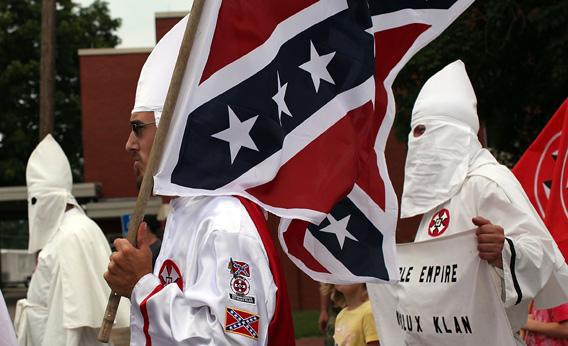The number of hate groups in the United States is on the rise, but the Ku Klux Klan is losing chapters, according to data released on Wednesday by the Southern Poverty Law Center. The number of KKK chapters dropped from 221 to 152 in just one year. Why is the Klan shrinking?
Consolidation and defections. The Klan is not a stable organization. There’s no real national leadership, and chapters are constantly appearing, disappearing, splitting, and merging. In 2010, to take one example, the True Invisible Empire Knights of Pulaski, Tenn., merged with the Traditional American Knights from Potosi, Mo. to form the True Invisible Empire Traditionalist American Knights of the Ku Klux Klan. (Note: this link, like others in this article, leads to an extremist website.) Such mergers decrease the number of chapters without necessarily changing membership totals. Not all the Klan’s losses are just on paper, though. Jeremy Parker, who led the Ohio-based Brotherhood of Klans, left the KKK for the Aryan Nations in 2010 and likely took a significant number of members with him. The Brotherhood of Klans was the second-largest Klan association in the country, with 38 chapters.
Membership totals are hard to track, because the Klan doesn’t willingly release member lists. Over the long term, the KKK is clearly contracting, since its rolls have shrunk from millions in the 1920s to between 3,000 and 5,000 today. But no one knows how membership has changed in the last few years.
Klan-watchers, however, suspect that the nation’s oldest domestic terrorist organization is indeed struggling to keep pace with other racist hate groups. Young racists tend to think of the Klan as their grandfathers’ hate group, and of its members as rural, uneducated, and technologically unsophisticated. The Klan doesn’t seem to have used the web and social media as well as its competitors. The group’s failure to effectively deploy technology is a bit of an irony, since one of those newfangled motion pictures, The Birth of a Nation, launched the KKK’s second era in 1915.
The Klan’s history of violence is another challenge to recruitment. The organization will always be associated with the lynching of innocent African-Americans in the 20th century, which puts off more moderate racists.
The KKK is also suffering from a proliferation of competitors. People who wanted to join a white supremacist movement back in the 1920s didn’t have a lot of choices. Today, there are countless options, enabling an extremist to find a group that matches his personal brand of intolerance. The more extreme groups in the burgeoning patriot movement cater to anti-Muslim, homophobic, and xenophobic sentiment, with less animosity toward African-Americans and Jews. Aryan Nations offers a heavy focus on Christian identity. Some groups preach more violence, while others offer a veneer of intellectualism. American Renaissance, for example, caters to “suit-and-tie” racists, offering pseudo-scientific papers on white supremacy. The group even holds conferences at a hotel near Dulles airport in Virginia.
Many young racist activists aren’t bothering to join groups at all anymore, further hampering the Klan’s recruitment efforts. Former KKK Grand Wizard Don Black in 1995 launched the website Stormfront, which enables individuals in the white supremacist movement to share ideas and read news stories reported from a racist perspective. The community-building site, and others like it, lessens the need for racists to socialize at Klan barbecues or introduce their children to Klanta Klaus at the KKK Christmas rally.
Got a question about today’s news? Ask the Explainer.
Explainer thanks Heidi Beirich of the Southern Poverty Law Center, Chris Hale of LSU-Shreveport, Brian Levin of the Center for the Study of Hate and Extremism at California State University-San Bernardino and co-editor of Hate Crimes, and Mark Pitcavage of the Anti-Defamation League.
Video Explainer: Can Animals Be Homophobic?
